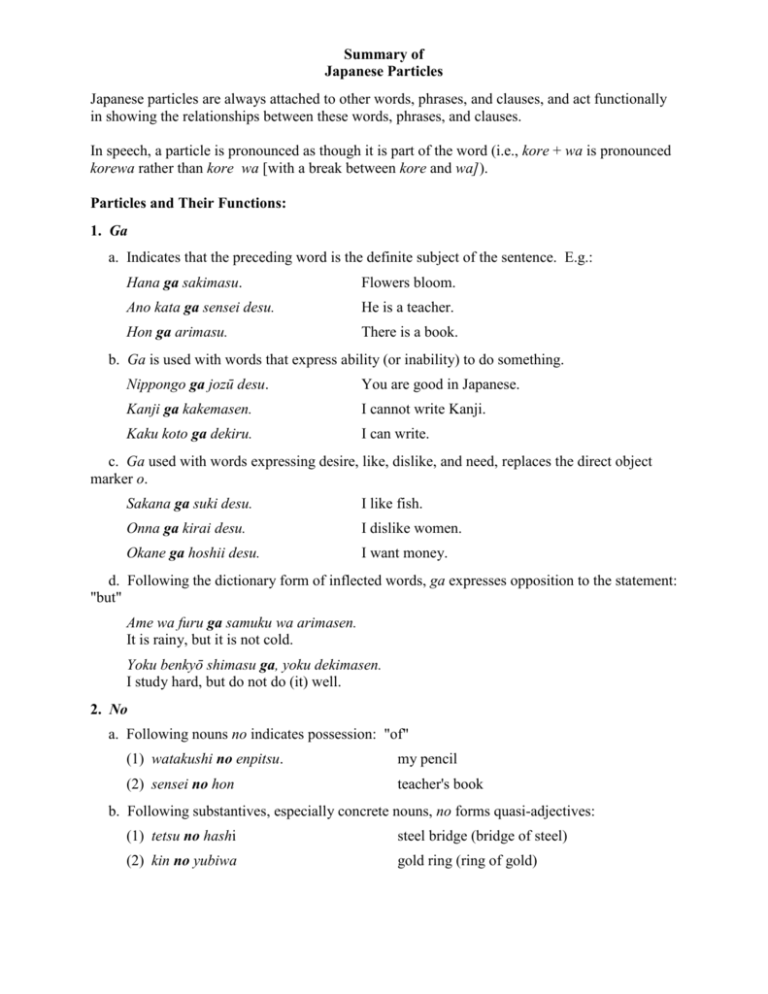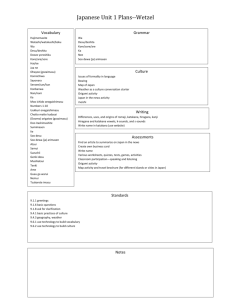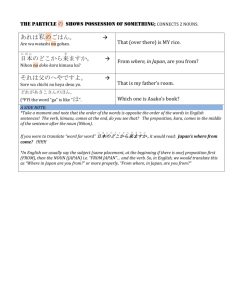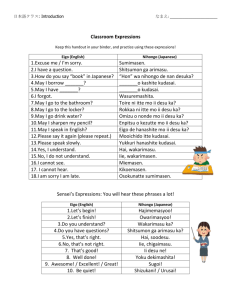Japanese Particles: A Comprehensive Summary
advertisement

Summary of Japanese Particles Japanese particles are always attached to other words, phrases, and clauses, and act functionally in showing the relationships between these words, phrases, and clauses. In speech, a particle is pronounced as though it is part of the word (i.e., kore + wa is pronounced korewa rather than kore wa [with a break between kore and wa]). Particles and Their Functions: 1. Ga a. Indicates that the preceding word is the definite subject of the sentence. E.g.: Hana ga sakimasu. Flowers bloom. Ano kata ga sensei desu. He is a teacher. Hon ga arimasu. There is a book. b. Ga is used with words that express ability (or inability) to do something. Nippongo ga jozū desu. You are good in Japanese. Kanji ga kakemasen. I cannot write Kanji. Kaku koto ga dekiru. I can write. c. Ga used with words expressing desire, like, dislike, and need, replaces the direct object marker o. Sakana ga suki desu. I like fish. Onna ga kirai desu. I dislike women. Okane ga hoshii desu. I want money. d. Following the dictionary form of inflected words, ga expresses opposition to the statement: "but" Ame wa furu ga samuku wa arimasen. It is rainy, but it is not cold. Yoku benkyō shimasu ga, yoku dekimasen. I study hard, but do not do (it) well. 2. No a. Following nouns no indicates possession: "of" (1) watakushi no enpitsu. my pencil (2) sensei no hon teacher's book b. Following substantives, especially concrete nouns, no forms quasi-adjectives: (1) tetsu no hashi steel bridge (bridge of steel) (2) kin no yubiwa gold ring (ring of gold) Summary of Japanese Particles c. Following the dictionary form of inflected words no serves to nominalize (make a noun out of) that which precedes it: (1) Asa hayaku okiru no wa karada ni ii desu. Getting up early in the morning is good for one's health. (2) Nippongo o benkyoo suru no wa omoshiroi desu. Studying Japanese is interesting. d. Pronoun use: following nouns and the dictionary form of adjectives and verbs, no is used as a pronoun: "-----one" (1) Atarashii no wa takai desu. New ones are expensive. (2) Shiroi no wa yasui desu. White ones are cheap. (3) Asoko ni iku no wa Yamada-san desu. The one that goes over there is Mr. Yamada. e. Following personal pronouns, no forms their possessive cases: “mine, his, ours, theirs, etc.” (1) Watakushi no wa atarashii desu. Mine is new. (2) Ano kata no wa akai desu. His is red. 3. O a. Following nouns, o indicates that whatever precedes it is the direct object: (1) Gohan o taberu. I eat meals. (2) Hon o yomu. I read books. b. Following nouns, o indicates the locale of locomotive action. (1) Machi o aruku. I walk through town. (2) Michi o sampo suru. I take a stroll on the road. 4. Ni a. Following nouns ni indicates locale with verbs of existence, iru, aru: “in, on" (1) Seito ga heya ni imasu. Students are in the room. (2) Iroiro no mono ga mise ni arimasu. There are various things in the store. Note: After ga, iru is used when the subject is animate, aru if the subject is inanimate. b. Following nouns ni indicates the point of arrival of actions: (1) Sensei ni narimasu. I will become a teacher. (2) Oya ni nite imasu. I resemble my parents. 2 Summary of Japanese Particles c. Following nouns and the gerund form of verbs, ni indicates the purpose of “coming” or “going.” (1) Hiruhan o tabe ni kaerimasu. I return to eat lunch. (2) Eiga o mi ni ikimasu. I go to see movies. d. Following nouns ni indicates the indirect object: “to” (1) Seito ni nippongo o oshieru. I teach Japanese to students. (2) Kodomo ni okane o okuru. I send money to my children. e. Following nouns ni indicates time, “at” or “on” (1) Watakushi wa rokuji ni okimasu. I get up at six. (2) Watakushi wa nichiyōbi ni kimasu. I will come on Sunday. f. Following nouns, ni indicates the meaning of “for” (1) Karada ni yoku wa arimasen. It is not good for one’s health. (2) Me ni warui desu. It is bad for the eyes. g. Following nouns, ni indicates destination of verbs of motion. (1) Gakkō ni ikimasu. I go to school. (2) San Furanshisuko ni kimasu. I will come to San Francisco. h. Ni suru after a noun or a pronoun means “to decide on” (1) Dotchi ni shimashō ka. . Which shall I decide on? (2) Ashita ni shimashō. Let’s make it tomorrow. 5. E a. Following nouns e indicates direction or place toward which an action moves: “to,” “toward” (1) Nippon e ikimasu. I go to Japan. (2) Gakkō e kuru. I come to school. 6. To a. Indicates the substantive to which it is attached is in a series of substantives, all of which are named: “and” (1) Sensei to seito ga imasu. There are teachers and students. (2) Enpitsu to hon ga arimasu. There are pencils and books. b. Following nouns to (or to issho ni) indicates accompaniment. (1) Tomodachi to asobimasu. I play with my friend. (2) Kodomo to sampo shimasu. I take walks with my children. 3 Summary of Japanese Particles 7. Ya Indicates that the substantive to which it is attached is in a series of substantives, incompletely named: “and” Note: ya is not used after the last substantive in the series. (1) Tsukue no ue ni hon ya enpitsu (nado) ga arimasu. There are books, and pencils, etc., on the desk. (2) Watakushi wa enpitsu ya kami (nado) o kaimashita. I bought pencils and paper, etc.” 8. De a. Following nouns, de indicates means: “with” (1) Enpitsu de kaku. I write with a pencil. (2) Me de mono o miru. I see things with my eyes. b. Following nouns de indicates materials of which things are made: “of” (1) Tsukue wa ki de koshiraete arimasu. The desk is made of wood. (2) Kono hako wa kami de koshiraete arimasu. This box is made of paper. c. Following place nouns, de indicates location where actions take place: “in, at” (1) Watakushi wa kono ho o mise de kaimashita. I bought this book at a store. (2) Watakushi wa Nippon de Fujisan o mimashita. I saw Mt. Fuji in Japan. Note: In these cases de should not be replaced with ni. h. Used idiomatically with ato, saki, means “later, in the future” (1) Ato de benkyō shimasu. I will study later. (2) Dewa mata ato de. . I’ll see you later. 9. Te a. The te form of verbs followed by iru indicates progressive action: (1) Yuki ga futte imasu. It is snowing. (2) Watakushi wa benkyō shite imasu. I am studying. b. The te form of verbs followed by iru indicates persisting state or the perfect tense (verbs are usually intransitive): (1) Yamamoto-san wa Nippon ni itte imasu. Mr. Yamamoto is in Japan. (He went to Japan in the past and is there now.) 4 Summary of Japanese Particles (2) Michi ni saifu ga ochite imasu. A purse is lying on the road. 10. Wa a. Wa is used to single out a word, phrase, or clause and is placed at the beginning of a sentence, and followed by a statement about it; conveys the notion of “as for” (1) Kore wa hon desu. This is a book. (As for this, it is a book.) (2) Asahan wa rokuji ni tabemasu. I eat breakfast at 6 o’clock. b. Wa is also used to emphasize the negative. Kore wa enpitsu de wa arimasen. This is not a pencil. 11. Mo a. Mo singles out an additional item that is similar to something already stated: “also, too.” Mo generally replaces wa, ga, and o and also follows other particles. (1) Ano kata mo seito desu. He, too, is a student. (2) Ano kata wa Nippongo mo hanashimasu. He speaks Japanese also. (3) Tsukue no ue ni hon mo arimasu. There are books on the desk, too. b. When used after each of two substantives (nouns) in a sentence or clause ending with a positive verb, mo expresses “both . . . and.” Ano kata wa Nippongo mo Eigo mo hanashimasu. He speaks both Japanese and English. c. When used in a sentence or clause ending with a negative verb, mo is translated “neither . . . nor.” In this case, the verb is translated positively. Ano kata wa Nippongo mo Eigo mo hanashimasen. He speaks neither Japanese nor English. d. When followed by negative verbs, mo converts interrogative pronouns into the corresponding “nothing, nobody, etc.” (1) Watakushi wa nani mo shiremasen. I don’t know anything. (2) Koko ni wa dare mo imasen. There is nobody here. e. Mo follows original particles to indicate “nowhere, to no one, etc.” (1) Watakushi wa doko e mo ikimasen. I go nowhere. (2) Dare ni mo aimasen deshita. I met no one. 5 Summary of Japanese Particles 12. Ka a. Coming at the end of a sentence, ka makes the sentence a question. b. Placed between two nouns, and after each of two clauses ka gives the meaning of “or, or . . . or.” (1) Enpitsu ka pen de kakimasu. I write with pencil or pen. (2) Kore wa hon desu ka, zasshi desu ka. Is this a book or a magazine? c. Following deshō and darō, ka expresses doubt: “I wonder if” (1) Ashita wa ame ga furu deshō ka. I wonder if it will rain tomorrow. (2) Mō jūniji darō ka. I wonder if it is already 12 o’clock. d. After many interrogative pronouns, ka converts the interrogative into corresponding indefinite pronouns or adverbs. (1) Nani-ka kudasai. Give me something. (2) Koko ni dare-ka imasu. There is somebody here. (3) Doko-ka ikimasu ka. Will (you) go somewhere? Note: the e is dropped in this case (not Doko-ka e ikimasu ka) e. Ka is used after each of two clauses to express the idea of “whether . . . or” (1) Ashita wa ame ga furu ka dō ka shirimasen. I don’t know whether it will rain tomorrow or not. I don’t know whether it is good or bad. (2) Sore wa ii ka warui ka wakarimasen. 13. Kara a. Following nouns, kara indicates the point of origin: “from” (1) Tōkyō kara Yokohama e ikimasu. I go from Tokyo to Yokohama. (2) Ichi kara jū made kazoete kudasai. Please count from one to ten. b. Following the conclusive-attributive base of verbs, adjectives, etc., kara indicates the cause or reason for the following statements: “because, since, as” (1) Ame da kara, ikimasen. Because it is rain(ing), I will not go. (2) Atsui kara, shigoto o shimasen. Because it is hot, I will not work. However, as a reason or excuse in reply to a question or accusation, kara is often used at the end of a statement. Naze ikimasen deshita ka. Why didn’t you go? Isogashikatta kara. Because I was busy. 6 Summary of Japanese Particles 14. Made a. Following nouns or the dictionary form of verbs, made indicates the point to which an action or state extends: “till, until, as far as, to” (1) Ichi kara jū made kazoete kudasai. Please count from one to ten. (2) Sanji made machimashita. I waited till 3 o’clock. 15. Yo Yo is a sentence-ending particle used for emphasis. (1) Ashita mata kuru yo. I will come again tomorrow! (2) Atsui desu yo. It is hot! 16. Na Na is a particle that follows quasi-adjectives (i.e., so-called “Chinese” adjectives). (1) Are wa kirei na uchi desu ne. That is a pretty house, isn’t it? (2) Kare wa suki na hito desu. He is a person I like. Note: na is dropped when a quasi-adjective is used before another verb: (3) Are wa kirei desu ne. That is pretty, isn’t? (4) Ano uchi wa kirei de wa arimasen. That house is not pretty. 17. Ne a. Following the dictionary form of inflected words, ne indicates disjunctive questions such as “isn’t it, aren’t you” (1) Kyō wa atsui desu ne. It’s hot today, isn’t it? It was awful weather yesterday, wasn’t (2) Kino wa warui tenki deshita ne. it? 7








